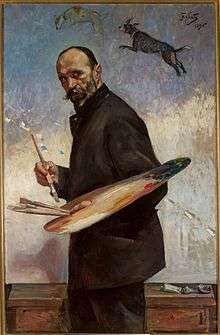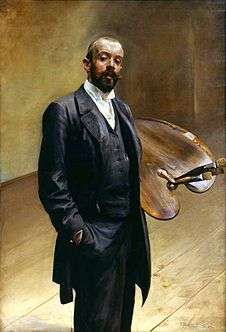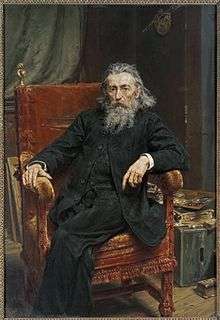Jan Matejko Academy of Fine Arts
|
Akademia Sztuk Pięknych w Krakowie im. Jana Matejki | |
|
Main building, on Kraków's Jan Matejko Square | |
| Type | Public |
|---|---|
| Established | 1818 |
| Rector | Professor Jan Pamuła |
Academic staff | 6 nine-month faculties |
Administrative staff | 353 |
| Students | 822 (2001/02) |
| Address | Plac Matejki 13, 31-157 Kraków, Kraków, Poland |
| Campus | Urban |
| Website | http://www.asp.krakow.pl |
The Jan Matejko Academy of Fine Arts, or the Kraków Academy of Fine Arts (Polish: Akademia Sztuk Pięknych w Krakowie im. Jana Matejki, usually abbreviated to ASP), is a public institution of higher learning located in downtown Kraków, Poland. It is the oldest Polish fine-arts academy, established in 1818 and granted full autonomy in 1873.
ASP is a state-run university that offers 5- and 6-year Master's degree programs. As of 2007, the Academy's faculty comprised 94 professors and assistant professors as well as 147 Ph.D.s.
History
The Academy of Fine Arts (ASP) was originally a subdivision of the Jagiellonian University's Department of Literature and was initially (1818–1873) called School of Drawing and Painting (Szkoła Rysunku i Malarstwa). Among its original teachers were Polish Neoclassicist Antoni Brodowski, and Franciszek Ksawery Lampi, a world-renowned landscape and portrait artist in Congress Poland whose most notable students there were Wojciech Korneli Stattler (teacher of Jan Matejko) and Piotr Michałowski, equestrian master artist of the Romantic period.[1]
ASP received the status of an independent institution of higher learning in 1873 as the School of Fine Arts (Szkoła Sztuk Pięknych). The first President of the Academy was painter Jan Matejko, who brought in other leading artists as professors including Jan Nepomucen Głowacki, the most outstanding landscape painter of the early 19th century in Poland,[2] as well as Florian Cynk, Aleksander Gryglewski and Leopold Loeffler, member of the Vienna Academy of Fine Arts. The main building based on a neoclassical design by architect Maciej Moraczewski was erected in today's Matejko Square in 1879. In 1893–95 its principal was a broadly educated Władysław Łuszczkiewicz (another teacher of Jan Matejko and later, his close associate) who also served as conservator of architectural monuments in the city.[3]
Following the death of Jan Matejko in 1893, the next ASP President elected in 1895 was Julian Fałat, who remained at his post until 1909. Fałat gave the Academy a new direction by hiring new art instructors associated with contemporary Western art philosophies; painters such as Teodor Axentowicz, Jacek Malczewski (the father of Polish Symbolism), Jan Stanisławski, Leon Wyczółkowski, Konstanty Laszczka, Józef Mehoffer, Stanisław Wyspiański (one of first in Europe to work in all genres), Wojciech Weiss, and Józef Pankiewicz among others.[4][5]
On the 100th anniversary of its founding, in 1979, the Academy was named for Jan Matejko, its founder and first president, who contributed greatly to its artistic legacy.
In 2008 the Academy joined Icograda (the International Council of Graphic Design Associations) and became that organization's first educational member in Poland.
Faculties

- Faculty of Painting
- Department of Painting
- Department of Drawing
- Department of Additional Specializations
- Department of Stage Design
- Faculty of Sculpture
- Department of Sculpture (I, II)
- Department of Drawing
- Department of Architecture-Sculpture Design
- Faculty of Interior Design
- Faculty of Intermedia
- Faculty of Industrial Design
- Department of Visual Communication
- Department of Product Design
- Faculty of Graphic Arts
- Department of Graphic Arts
- Department of Graphic Design
- Department of Drawing and Painting
- Faculty of Art Conservation
- Interdisciplinary Department of Art History
Notable graduates
 |
 |
 |
.jpg) |
 |
 |
| Selfportraits of leading professors and graduates | |||||
See also
References
- ↑ "Franciszek Ksawery Lampi (1782 - 1852)". Informacje o twórcy. Dom Aukcyjny Agra-Art. October 2012. Retrieved October 29, 2012.
Skłócony z ojcem, w 1814 wyjechał na Węgry, skąd ok. 1815 przybył do Polski i zamieszkał w Warszawie.
- ↑ "Jan Nepomucen Głowacki". Malarstwo polskie XIX wieku. Katalog zbiorów Muzeum Narodowego w Krakowie (in Polish). Muzeum Narodowe w Krakowie. 2001. Retrieved August 22, 2012.
- ↑ Nina Kinitz (October 8, 2009). "Sztuka zrodzona z historycznej pasji – obrazy Władysława Łuszczkiewicza". Malarstwo. Realizm (in Polish). Polskie muzy. Retrieved August 9, 2012.
- ↑ Irena Kossowska (October 2002). "Jacek Malczewski". Symbolizm w polskim malarstwie przełomu XIX i XX wieku (in Polish). Instytut Sztuki Polskiej Akademii Nauk. Culture.pl. Retrieved October 17, 2012.
- ↑ Marcin Grota (1996). "Malczewski's Mythology". Malczewski exhibition at the Czartoryski Museum (Warsaw Voice review). University of Buffalo. Info.Poland. Retrieved October 17, 2012.
External links
Coordinates: 50°03′59″N 19°56′30″E / 50.06639°N 19.94167°E
